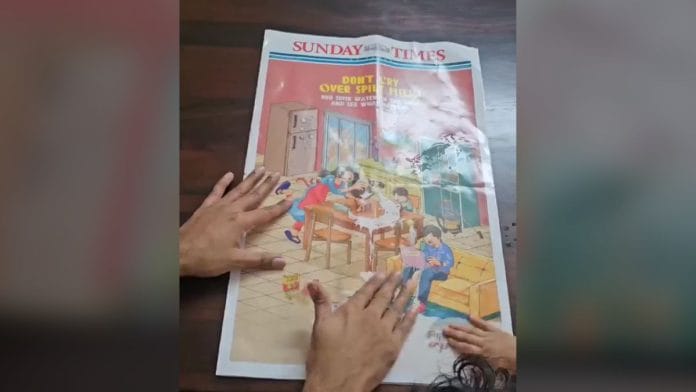Flipkart’s front-page jacket ad in the Hindustan Times and The Times of India last Sunday made waves on the internet as it transformed a typical newspaper read into an interactive experience. The ad didn’t just catch eyes—it shattered the mould of mundane print advertising.
A small swipe with a wet tissue was all it took to reveal hidden messages on the front pages, cleverly announcing Flipkart’s new feature: 10-minute delivery of groceries, electronics, and other products.
The innovative design allowed the message to reappear after a brief wait, letting readers enjoy the magic twice, blending creativity with a sense of discovery.
This ad was more than just a promotion; it transformed an everyday activity into a playful, mini science experiment that surprised and delighted readers over their morning coffee.
The brains behind this marketing gimmick are Pratik Shetty, Marketing and Media Head at Flipkart, and the creative team at Leo Burnett.
“We have finally reached that point where we are asking you to pour water on your morning Newspaper. Our ad in Mumbai, Bangalore and Delhi editions today. No need to panic for last minute needs anymore as we will deliver everything that you need in minutes. Also, a fun activity to do with kids as the ink reappears when dry,” Shetty wrote in a LinkedIn post.
The ad was downright outlandish, over-the-top, and maybe just a little bit fun. It was a gamble, no doubt, and the brand likely emptied its pockets to make this happen in the Mumbai, Bangalore, and Delhi editions of the two biggest dailies.
But here’s the kicker: it offers a glimmer of hope. If handled with a spark of creativity, print can still make waves—without always requiring a king’s ransom to do so.
Power of print
Over the years, there’s been an ongoing narrative about print media’s demise, but the numbers tell a different story.
India has around 17,000 newspaper titles and the circulation figure is around 40 crore. That’s a mighty audience, and it’s not going anywhere.
“There is a certain power in print,” said Suyash Khabya, Chief Creative Officer at The Womb, a Mumbai-based creative agency.
“Newspapers have a physicality to it. When a sales manager wants to encourage a shopkeeper to keep more of this product stock, he shows the physical newspaper print ad. This builds confidence in the shopkeeper about the efforts that the brand is doing to promote sales. No shopkeeper can be convinced with a meme or a six-second pre-roll,” he said.
A full-page jacket ad in top dailies can cost between Rs 5–10 lakh. The price depends on several factors, including location, page preference, colour or black-and-white, day, date, and season.
“Still, real estate, finance, automobile, and jewellery brands always have a print ad in their respective media budgets. Because newspapers have weight and consumers think twice before investing in these areas. You have to prove your credibility,” added Khabya.
Also read: Mentos is not saying ‘yes to fresh’. New campaign is a yawn
The ‘talking newspaper’
Brands have been pushing creative boundaries in print advertising to keep the medium relevant and engaging. But, in bits and pieces.
The last print ad that stood out was Volkswagen’s innovative ‘talking newspaper’ commercial’ in 2010. In this advertisement, Volkswagen used the actual newspaper as part of the storytelling process.
A small device was attached to two English dailies, which played an audio advertisement for the Volkswagen Vento when readers turned the page.
This idea was bizarre at the time, because a talking newspaper was beyond everyone’s imagination.
Other than this, brands have also attached small sachets or samples of soaps, sauces, shampoos, and other FMCG products to newspapers.
Just as Volkswagen and Flipkart utilised the inherent attributes of print—its tangible nature and the direct connection it has with readers—a need for more such creativity is critical for the survival of the medium.
The days when simply placing an ad in a newspaper guaranteed attention are long gone. Today, brands must experiment with interactive formats, such as pop-ups, scratch-and-sniff features, or tactile elements that appeal to the senses.
Flipkart and Volkswagen aren’t definitive templates for brands to emulate, but they’ve certainly set the stage for innovation. Their concepts hold potential. Hopefully, it won’t take another decade or more to see truly groundbreaking or unconventional ideas emerge in the print media space.
Brand: Flipkart
Agency: Leo Burnett (Mumbai)
Views are personal.






